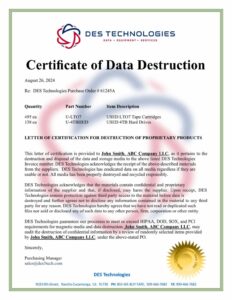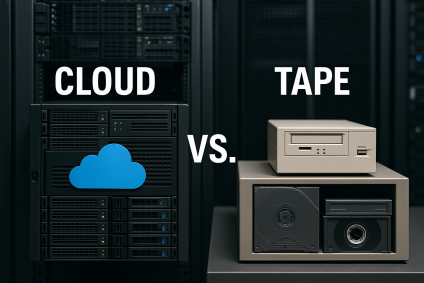Certified Data Destruction & Secure Data Eradication for the Big Data Supply Chain
The Growing Security Risk You Can’t Ignore
By 2025, global data volume is projected to surpass 180 zettabytes. For businesses, that’s more than just a staggering number—it’s a massive security liability.
Whether you operate a data center, manage enterprise IT infrastructure, or simply store customer information, you are part of the Big Data supply chain. This chain spans every stage of data handling: collection, processing, storage, and, eventually, destruction.
Here’s the reality:
If even one retired server, LTO tape, or SSD leaves your facility without certified, verifiable eradication, you put your entire supply chain—and your reputation—at risk.
In this guide, we’ll cover:
-
What a data destruction certificate really means
-
Why secure eradication is different from physical destruction
-
The impact on Big Data supply chain security
-
How to choose the right ITAD partner
-
Real-world case studies that prove the stakes
What Is a Data Destruction Certificate—and Why It Matters
A data destruction certificate is a verifiable document from your IT asset disposition (ITAD) provider confirming:
-
Which assets were destroyed or sanitized
-
The destruction method used (erasure, degaussing, shredding, etc.)
-
Date and location of service
-
Who performed the work
-
Serial numbers of each data-bearing device
Why it’s critical:
-
Compliance Shield — Required for audits and investigations under GDPR, HIPAA, CCPA, SOX, and other regulations.
-
Vendor Trust — Proves to partners that you take data security seriously.
-
Insurance Proof — Many cyber insurance policies require this documentation.
If your provider only offers a vague one-line confirmation, that’s not compliance—it’s negligence.

sample certificate of data destruction
Secure Data Eradication vs. Physical Destruction — The Key Differences
| Secure Data Eradication | Secure Data Destruction |
|---|---|
| Software-based removal making data unrecoverable, even with forensic tools | Physical destruction rendering media unusable |
| Preserves hardware for resale or reuse | Hardware is destroyed permanently |
| Meets NIST 800-88 and ISO 27040 standards | Methods include shredding, crushing, or incineration |
| Ideal for maximizing asset value | Best for classified or ultra-sensitive data |
Bottom line: Secure eradication can often be safer and more profitable—especially when resale value matters.
Protecting the Big Data Supply Chain
The Big Data supply chain is an interconnected network of data creators, processors, and storage providers. A breach at one point can cause global repercussions.
Risks of skipping certified eradication:
-
Data Leaks — Sensitive information resold on second-hand markets
-
Intellectual Property Theft — Competitors stealing AI training datasets
-
Regulatory Fines — GDPR, HIPAA, and CCPA penalties
-
Loss of Trust — The hardest business asset to recover
Why Physical Destruction Alone Isn’t Enough
Shredders aren’t infallible. Risks include:
-
Incorrect shred size leaving recoverable fragments
-
SSD chips surviving partial shredding
-
Magnetic tape data recoverable from strips
Best practice:
Pair secure eradication with physical destruction for high-risk assets, using equipment certified to NSA or DIN 66399 standards, and always verify results with third-party audits.

Choosing the Right ITAD Partner
Non-negotiable selection criteria:
- Standards Compliance — NIST 800-88 Rev. 1, ISO 27040
-
Full Chain-of-Custody — Detailed tracking from pickup to destruction
-
On-site & Off-site Options — Flexibility for security needs
-
Environmental Responsibility — Zero landfill policy
Red flag: If a vendor won’t let you witness destruction or provide a detailed asset list, you’re dealing with unnecessary risk.
The ROI of Doing It Right
Secure data eradication isn’t just a cost—it’s an investment.
Returns include:
-
Revenue from resold sanitized equipment
-
Faster, easier audits
-
Cyber insurance eligibility
-
Breach avoidance—critical when the average 2025 breach costs $4.76 million (IBM)

Real-World Case Studies
Case Study #1: Financial Institution Success Story
A Fortune 500 bank needed to decommission a data center while staying compliant with PCI-DSS and SOX.
-
92% of hardware was securely wiped and resold, netting $175,000 in recovered value
-
Remaining 8% destroyed to NSA standards
-
Passed a surprise audit with zero compliance issues
Case Study #2: Healthcare Provider Breach
A regional hospital relied on a low-cost recycler for “free” destruction—without certificates.
-
Incomplete shredding left SSD chips and magnetic tapes recoverable
-
Patient data surfaced overseas, triggering $3.1 million in fines and lost contracts
-
Damage to public trust reduced patient enrollment by 15%
Why Partner with WeBuyUsedITequipment.net (Powered by DES Technologies)
We:
-
Provide destruction certificates with full serial tracking
-
Offer both secure eradication and physical destruction
-
Comply with global standards
-
Support Fortune 500, healthcare, and government clients nationwide
FAQs
Q: Is deleting files enough?
A: No. Deleted files can be easily recovered—only certified eradication or destruction is safe.
Q: Can tapes and drives be reused after eradication?
A: Yes, if sanitized to NIST 800-88 standards.
Q: On-site or off-site destruction—what’s better?
A: On-site minimizes transport risk, but both can be secure with strict chain-of-custody.
Don’t gamble with your data or your reputation.
Request a free Big Data supply chain security assessment today from WeBuyUsedITequipment.net and protect your business from costly breaches.







